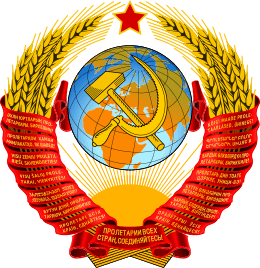Republics of the Soviet Union
The Republics of the Union of Soviet Socialist Republics or Union Republics (Russian: Сою́зные Респу́блики, tr. Soyúznye Respúbliki) were the ethnically based proto-states of the Union of Soviet Socialist Republics (USSR).[1] For most of its history, the USSR was a highly centralized state; the decentralization reforms during the era of Perestroika ("Restructuring") and Glasnost ("Openness") conducted by Mikhail Gorbachev are cited as one of the factors which led to the dissolution of the USSR in 1991.
| Republics of the USSR | |
|---|---|
 | |
| Category | Federated state |
| Location | |
| Created by | Treaty on the Creation of the USSR |
| Created | 30 December 1922 |
| Abolished by | State Council recognition of the Baltic states independence Declaration no. 142-Н |
| Abolished | 6 September 1991 26 December 1991 |
| Number | 15 (as of 1989) |
| Populations | Smallest: 1,565,662 (Estonian SSR) Largest: 147,386,000 (Russian SFSR) |
| Areas | Smallest: 29,800 km2 (11,500 sq mi) (Armenia) Largest: 17,075,400 km2 (6,592,800 sq mi) (Russian SFSR) |
| Government | Unitary Marxist-Leninist one-party socialist republics |
| Subdivisions | Autonomous SSRs, oblasts, Autonomous oblasts, |
| Eastern Bloc | |||||||
|---|---|---|---|---|---|---|---|
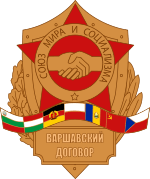 | |||||||
|
Allied states
|
|||||||
|
Related organizations |
|||||||
|
Dissent and opposition
|
|||||||
There were two different types of republics in the Soviet Union: union republics which, according to the Soviet Constitution, had the right of seccession from the Soviet Union and autonomous republics which subordinated to union republics in which they were located. The autonomous status of all republics was nominal and was fully controlled by the Communist Party of the Soviet Union and government of the Soviet Union that was also controlled by the Party. Before adaptation of the "Perestroika" policy of political liberalization in 1980s, any deviation from the Party policy in any form was subject to legal persecutions.
In 1940, a new entity was created for the annexation of Finland (see Winter War). The Karelo-Finnish Soviet Socialist Republic became the only union republic from which such status was completely removed in 1956 without any form of discussion including referendum.
Overview
According to Article 76 of the 1977 Soviet Constitution, a Union Republic was a sovereign Soviet socialist state that had united with other Soviet Republics in the USSR. Article 81 of the Constitution stated that "the sovereign rights of Union Republics shall be safeguarded by the USSR".[2]
In the final decades of its existence, the Soviet Union officially consisted of fifteen Soviet Socialist Republics (SSRs). All of them, with the exception of the Russian Federation (until 1990), had their own local party chapters of the All-Union Communist Party.
Outside the territory of the Russian Federation, the republics were constituted mostly in lands that had formerly belonged to the Russian Empire and had been acquired by it between the 1700 Great Northern War and the Anglo-Russian Convention of 1907.
In 1944, amendments to the All-Union Constitution allowed for separate branches of the Red Army for each Soviet Republic. They also allowed for Republic-level commissariats for foreign affairs and defense, allowing them to be recognized as de jure independent states in international law. This allowed for two Soviet Republics, Ukraine and Byelorussia, (as well as the USSR as a whole) to join the United Nations General Assembly as founding members in 1945.[3][4][5]
All of the former Republics of the Union are now independent countries, with ten of them (all except the Baltic states, Georgia and Ukraine) being very loosely organized under the heading of the Commonwealth of Independent States. The Baltic states assert that their incorporation into the Soviet Union in 1940 (as the Lithuanian, Latvian, and Estonian SSRs) under the provisions of the 1939 Molotov–Ribbentrop Pact was illegal, and that they therefore remained independent countries under Soviet occupation.[6][7] Their position is supported by the European Union,[8] the European Court of Human Rights,[9] the United Nations Human Rights Council[10] and the United States.[11] In contrast, the Russian government and state officials maintain that the Soviet annexation of the Baltic states was legitimate.[12] Constitutionally, the Soviet Union was a federation. In accordance with provisions present in the Constitution (versions adopted in 1924, 1936 and 1977), each republic retained the right to secede from the USSR. Throughout the Cold War, this right was widely considered to be meaningless; however, the corresponding Article 72 of the 1977 Constitution was used in December 1991 to effectively dissolve the Soviet Union, when Russia, Ukraine, and Belarus seceded from the Union.
In practice, the USSR was a highly centralised entity from its creation in 1922 until the mid-1980s when political forces unleashed by reforms undertaken by Mikhail Gorbachev resulted in the loosening of central control and its ultimate dissolution. Under the constitution adopted in 1936 and modified along the way until October 1977, the political foundation of the Soviet Union was formed by the Soviets (Councils) of People's Deputies. These existed at all levels of the administrative hierarchy, with the Soviet Union as a whole under the nominal control of the Supreme Soviet of the USSR, located in Moscow within the Russian SFSR.
Along with the state administrative hierarchy, there existed a parallel structure of party organizations, which allowed the Politburo to exercise large amounts of control over the republics. State administrative organs took direction from the parallel party organs, and appointments of all party and state officials required approval of the central organs of the party.
Each republic had its own unique set of state symbols: a flag, a coat of arms, and, with the exception of Russia until 1990, an anthem. Every republic of the Soviet Union also was awarded with the Order of Lenin.
 A hall in Bishkek's Soviet-era Lenin Museum decorated with the flags of Soviet Republics
A hall in Bishkek's Soviet-era Lenin Museum decorated with the flags of Soviet Republics Poster of the unity of the Soviet republics in the late 1930s. All republics, except Russia, are shown with their respective traditional clothes.
Poster of the unity of the Soviet republics in the late 1930s. All republics, except Russia, are shown with their respective traditional clothes. Poster of the unity of the Soviet republics in the late 1940s. Note that the map also points out the Karelo-Finnish SSR capital, Petrozavodsk.
Poster of the unity of the Soviet republics in the late 1940s. Note that the map also points out the Karelo-Finnish SSR capital, Petrozavodsk.
Union Republics of the Soviet Union
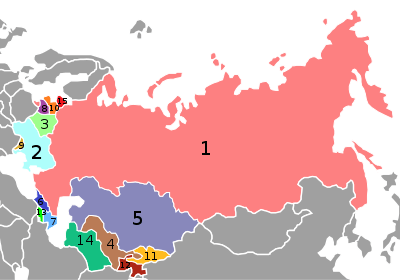
The number of the union republics of the USSR varied from 4 to 16. In majority of years and at the later decades of its existence, the Soviet Union consisted of 15 Soviet Socialist Republics. Rather than listing the republics in alphabetical order, the republics were listed in constitutional order, which, particularly by the last decades of the Soviet Union, did not correspond to order either by population or economic power.
| Emblem | Name | Flag | Capital | Official languages | Joined | Sovereignty / Independence |
Population (1989) | Pop. % |
Area (km²) (1991) | Area % |
Post-Soviet states | No. |
|---|---|---|---|---|---|---|---|---|---|---|---|---|
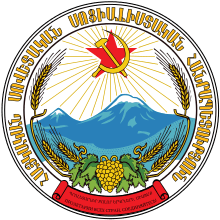 |
Armenian Soviet Socialist Republic | .svg.png) |
Yerevan | Armenian, Russian | 1922 | August 23, 1990 September 21, 1991 |
3,287,700 | 1.15 | 29,800 | 0.13 | 13 | |
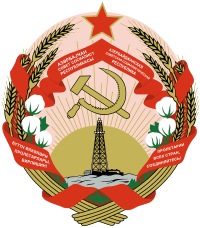 |
Azerbaijan Soviet Socialist Republic | .svg.png) |
Baku | Azerbaijani, Russian | 1922 | September 23, 1989 October 18, 1991 |
7,037,900 | 2.45 | 86,600 | 0.39 | 7 | |
.svg.png) |
Byelorussian Soviet Socialist Republic | .svg.png) |
Minsk | Byelorussian, Russian | 1922 | July 27, 1990 August 25, 1991 |
10,151,806 | 3.54 | 207,600 | 0.93 | 3 | |
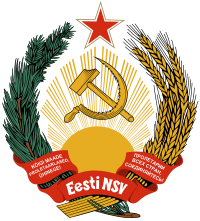 |
Estonian Soviet Socialist Republic[lower-alpha 1] | .svg.png) |
Tallinn | Estonian, Russian | 1940 | November 16, 1988 August 20, 1991 |
1,565,662 | 0.55 | 45,226 | 0.20 | 15 | |
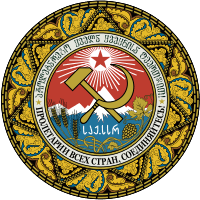 |
Georgian Soviet Socialist Republic | .svg.png) |
Tbilisi | Georgian, Russian | 1922 | November 18, 1989 April 9, 1991 |
5,400,841 | 1.88 | 69,700 | 0.31 | 6 | |
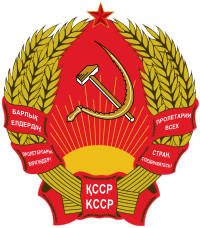 |
Kazakh Soviet Socialist Republic | 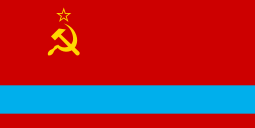 |
Alma-Ata | Kazakh, Russian | 1936 | October 25, 1990 December 10, 1991 |
16,711,900 | 5.83 | 2,717,300 | 12.24 | 5 | |
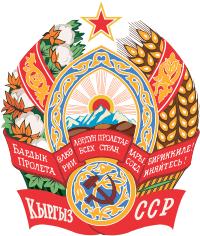 |
Kirghiz Soviet Socialist Republic | 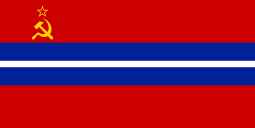 |
Frunze | Kirghiz, Russian | 1936 | December 15, 1990 August 31, 1991 |
4,257,800 | 1.48 | 198,500 | 0.89 | 11 | |
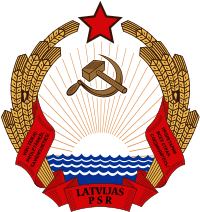 |
Latvian Soviet Socialist Republic[lower-alpha 1] | .svg.png) |
Riga | Latvian, Russian | 1940 | July 28, 1989 May 4, 1990 |
2,666,567 | 0.93 | 64,589 | 0.29 | 10 | |
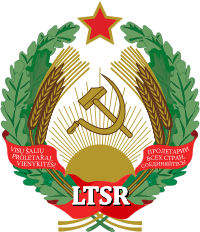 |
Lithuanian Soviet Socialist Republic[lower-alpha 1] | .svg.png) |
Vilnius | Lithuanian, Russian | 1940 | May 18, 1989 March 11, 1990 |
3,689,779 | 1.29 | 65,200 | 0.29 | 8 | |
.svg.png) |
Moldavian Soviet Socialist Republic | .svg.png) |
Kishinev | Moldavian, Russian | 1940 | June 23, 1990 August 27, 1991 |
4,337,600 | 1.51 | 33,843 | 0.15 | 9 | |
 |
Russian Soviet Federative Socialist Republic | .svg.png) |
Moscow | Russian | 1922 | June 12, 1990 December 12, 1991 |
147,386,000 | 51.40 | 17,075,400 | 76.62 | 1 | |
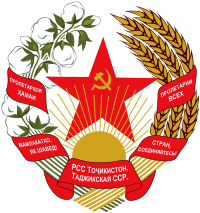 |
Tajik Soviet Socialist Republic | 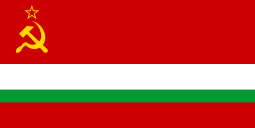 |
Dushanbe | Tajik, Russian |
1929 | August 24, 1990 September 9, 1991 |
5,112,000 | 1.78 | 143,100 | 0.64 | 12 | |
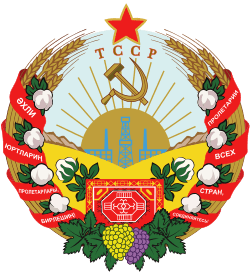 |
Turkmen Soviet Socialist Republic | .svg.png) |
Ashkhabad | Turkmen, Russian | 1924 | August 27, 1990 October 27, 1991 |
3,522,700 | 1.23 | 488,100 | 2.19 | 14 | |
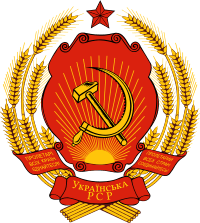 |
Ukrainian Soviet Socialist Republic | 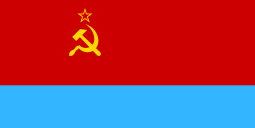 |
Kiev | Ukrainian, Russian | 1922 | July 16, 1990 August 24, 1991 |
51,706,746 | 18.03 | 603,700 | 2.71 | 2 | |
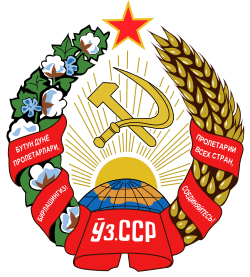 |
Uzbek Soviet Socialist Republic | .svg.png) |
Tashkent | Uzbek, Russian |
1924 | June 20, 1990 August 31, 1991 |
19,906,000 | 6.94 | 447,400 | 2.01 | 4 |
Former Union Republics of the Soviet Union
| Emblem | Name | Flag | Capital | Titular nationality | Years of membership | Population | Area (km²) | Soviet successor |
|---|---|---|---|---|---|---|---|---|
 |
Bukharan People's Soviet Republic | 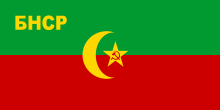 |
Bukhara | Uzbeks, Tajiks, Turkmens | 1920–1925 | 2,000,000 | 182,193 | |
 |
Karelo-Finnish Soviet Socialist Republic | 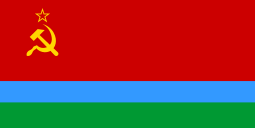 |
Petrozavodsk | Karelians | 1940–1956 | 651,300 (1959) |
172,400 | |
.svg.png) |
Khorezm People's Soviet Republic |  |
Khiva | Uzbeks, Turkmens | 1920–1925 | 800,000 | 62,200 | |
.svg.png) |
Transcaucasian Socialist Federative Soviet Republic | .svg.png) |
Tiflis | Azeris, Armenians, Georgians | 1922–1936 | 5,861,600 (1926) |
186,100 |
Republics not recognized by the Soviet Union
| Emblem | Name | Flag | Capital | Official languages | Independence from Moldavian SSR declared | Independence from USSR declared | Population | Area (km²) | Post-Soviet states |
|---|---|---|---|---|---|---|---|---|---|
 |
Pridnestrovian Moldavian Soviet Socialist Republic | .svg.png) |
Tiraspol | Russian, Ukrainian, Moldovan | 2 September 1990 | 25 August 1991 | 680,000 (1989) |
4,163 (1989) |
|
Other non-union Soviet republics
The Turkestan Soviet Federative Republic was proclaimed in 1918 but did not survive to the founding of the USSR, becoming the short-lived Turkestan Autonomous Soviet Socialist Republic of the RSFSR. The Crimean Soviet Socialist Republic (Soviet Socialist Republic of Taurida) was also proclaimed in 1918, but did not became a union republic and was made into an autonomous republic of the RSFSR, although the Crimean Tatars had a relative majority until the 1930s or 1940s according to censuses. When the Tuvan People's Republic joined the Soviet Union in 1944, it did not become a union republic, and was instead established as an autonomous republic of the RSFSR.
The leader of the People's Republic of Bulgaria, Todor Zhivkov, suggested in the early 1960s that the country should become a union republic, but the offer was rejected.[16][17][18] During the Soviet–Afghan War, the Soviet Union proposed to annex Northern Afghanistan as its 16th union republic in what was to become the Afghan Soviet Socialist Republic.[19]
Unrealized Soviet states
Workers' communes
- The Volga Germans Workers' Commune
- The Estland Workers' Commune
- The Karelian Workers' Commune
- The Petrograd Workers' Commune, later the Northern Oblast Communes Association
Autonomous Republics of the Soviet Union
Several of the Union Republics themselves, most notably Russia, were further subdivided into Autonomous Soviet Socialist Republics (ASSRs). Though administratively part of their respective Union Republics, ASSRs were also established based on ethnic/cultural lines.
Former Autonomous Soviet Socialist Republics of the Soviet Union
Dissolution of the Soviet Union
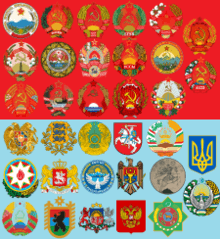
Under Mikhail Gorbachev, glasnost ("openness") and perestroika ("restructuring") were intended to liberalise and open up the Soviet Union. However, they had a number of effects which caused the power of the republics to increase. First, political liberalization allowed the governments within the republics to gain legitimacy by invoking democracy, nationalism, or a combination of both. In addition, liberalization led to fractures within the Communist Party which resulted in reduced ability to govern the Union effectively. The rise of nationalist and right-wing movements, notably led in Russia by Boris Yeltsin, in the previously homogeneously Communist political system led to the crumbling of the Union's foundations. With the central role of the Communist Party removed from the constitution, the Communist Party lost its control over the political system and was banned from operating after an attempted coup d'état.
Throughout the unravelling of the restructuring, the Soviet government attempted to find a new structure which would reflect the increased power of the republics. Some autonomous republics, like Tatarstan, Checheno-Ingushetia, Abkhazia, South Ossetia, Crimea, Transnistria, Gagauzia sought the union statute in New Union Treaty. Efforts to found a Union of Sovereign States proved unsuccessful and the republics began to secede from the Union. By 6 September 1991, the Soviet Union's State Council recognized the independence of Estonia, Latvia and Lithuania bringing the number of union republics down to 12. On 8 December 1991, the remaining leaders of the republics signed the Belavezha Accords which agreed that the USSR would be dissolved and replaced with a Commonwealth of Independent States. On 25 December, President Gorbachev announced his resignation and turned all executive powers over to Yeltsin. The next day the Council of Republics voted to dissolve the Union. Since then, the republics have been governed independently with some adopting significantly more liberal policies while others, particularly in Central Asia, have retained leadership personnel from the Soviet time to this day.
See also
- Dissolution of the Soviet Union
- Flags of the Soviet Republics
- Emblems of the Soviet Republics
- Commonwealth of Independent States
- Eurasian Economic Union
- National delimitation in the Soviet Union
- Bavarian Soviet Republic
- Hungarian Soviet Republic
- Slovak Soviet Republic
- Limerick Soviet
- Paris Commune
- Provisional Polish Revolutionary Committee (Polish SSR)
- Republics of Russia
- Federal subjects of Russia
- Post-Soviet states (former Soviet Republics)
Notes
- The annexation of the Baltic republics in 1940 is considered an illegal occupation by the current Baltic governments and by a number of foreign countries.[6][9][10][11][13][14][15] The Soviet Union considered the initial annexation legal, but officially recognized their independence on September 6, 1991, three months prior to its final dissolution
- Known as Oyrot Autonomous Oblast in 1922-1948 and Gorno-Altai Autonomous Oblast in 1948-1990.
References
- Hough, Jerry F (1997). Democratization and revolution in the USSR, 1985-1991. Brookings Institution Press. p. 214. ISBN 0-8157-3749-1.
- Federalism and the Dictatorship of Power in Russia By Mikhail Stoliarov. Taylor & Francis. 2014. p. 56. ISBN 0-415-30153-X. Retrieved 2014-02-18.
- "Walter Duranty Explains Changes In Soviet Constitution,". Miami News. News.google.com. 1944-02-06. Retrieved 2014-02-18.
- "League of Nations Timeline - Chronology 1944". Indiana.edu. Retrieved 2014-02-18.
- "United Nations - Founding Members". Un.org. Retrieved 2014-02-18.
- "The Occupation of Latvia at Ministry of Foreign Affairs of the Republic of Latvia". Am.gov.
- "Estonia says Soviet occupation justifies it staying away from Moscow celebrations". Pravda.Ru. 3 May 2005. Archived from the original on 29 September 2007.
- Motion for a resolution on the Situation in Estonia by the EU
- European Court of Human Rights cases on Occupation of Baltic States
- "UNITED NATIONS Human Rights Council Report". Ap.ohchr.org. Retrieved 2014-02-18.
- "U.S.-Baltic Relations: Celebrating 85 Years of Friendship" (PDF). U.S. Department of State. 14 June 2007. Archived from the original (PDF) on 19 August 2012. Retrieved 29 July 2009.
- Russia denies Baltic 'occupation' by BBC News
- European parliament: Resolution on the situation in Estonia, Latvia and Lithuania (No C 42/78) (1983). Official Journal of the European Communities. European Parliament.
- Aust, Anthony (2005). Handbook of International Law. Cambridge University Press. ISBN 978-0-521-53034-7.
- Ziemele, Ineta (2005). State Continuity and Nationality: The Baltic States and Russia. Martinus Nijhoff Publishers. ISBN 90-04-14295-9.
- Elster, Jon (1996). The roundtable talks and the breakdown of communism. University of Chicago Press. p. 179. ISBN 0-226-20628-9.
- Held, Joseph (1994). Dictionary of East European history since 1945. Greenwood Press. p. 84. ISBN 0-313-26519-4.
- Gökay, Bülent (2001). Eastern Europe since 1970. Longman. p. 19. ISBN 0-582-32858-6.
- Soviets may be poised to annex the Afghan North - Chicago Tribune. August 19, 1984. Retrieved on December 10, 2016. "Miraki said then-Soviet leader Leonid Brezhnev urged Afghan President Babrak Karmal to win Afghan Communist Party approval for Moscow's annexation of eight northern provinces and their formation into the 16th Soviet republic, the Socialist Republic of Afghanistan. The defector said Brezhnev envisioned the southern half of the country as a powerless, Pa-than-speaking buffer with U.S.-backed Pakistan."

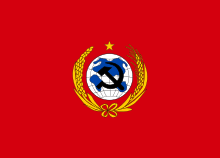



.svg.png)
.svg.png)
.svg.png)


.svg.png)
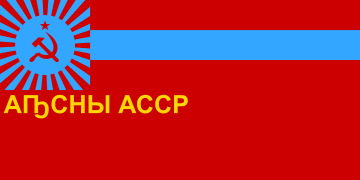
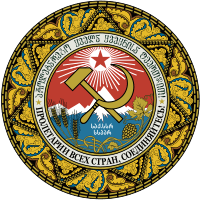

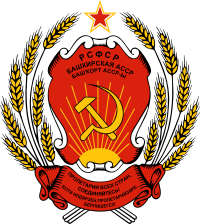
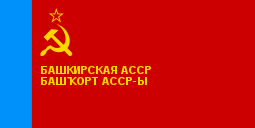


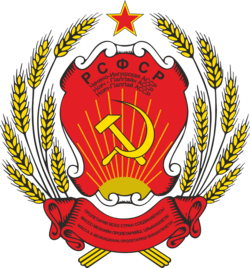
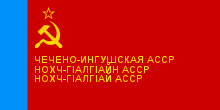
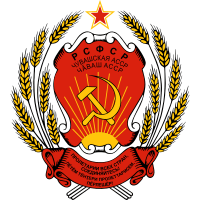
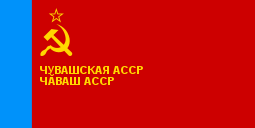
.svg.png)

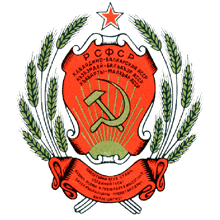
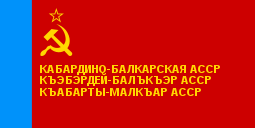
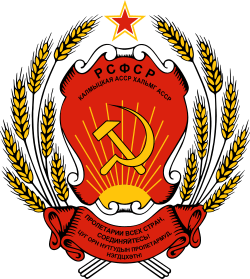
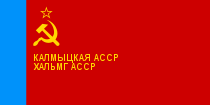

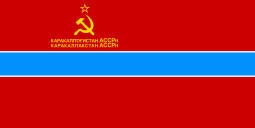
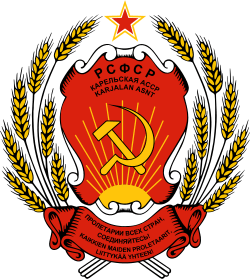


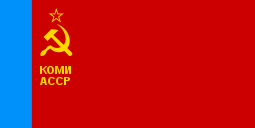

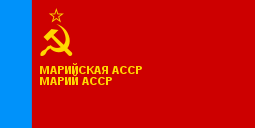
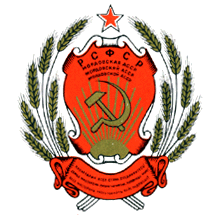
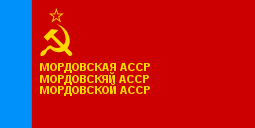


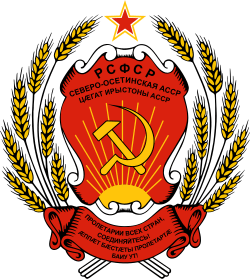
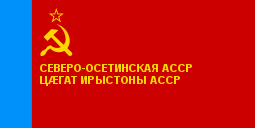
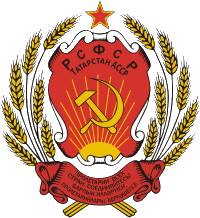
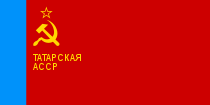
.svg.png)
.svg.png)
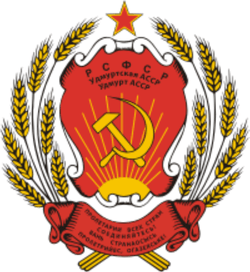
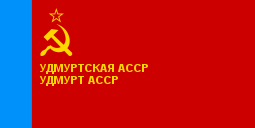
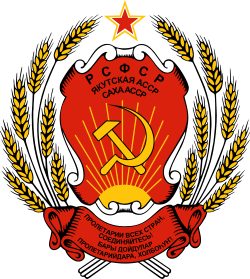
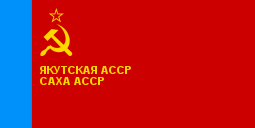
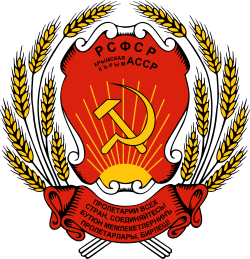
.svg.png)
.svg.png)
.svg.png)
.gif)
.svg.png)
.png)
.svg.png)
.svg.png)

.svg.png)
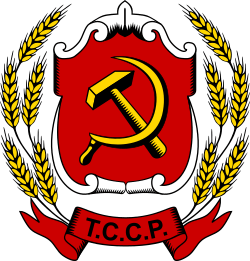
.svg.png)


